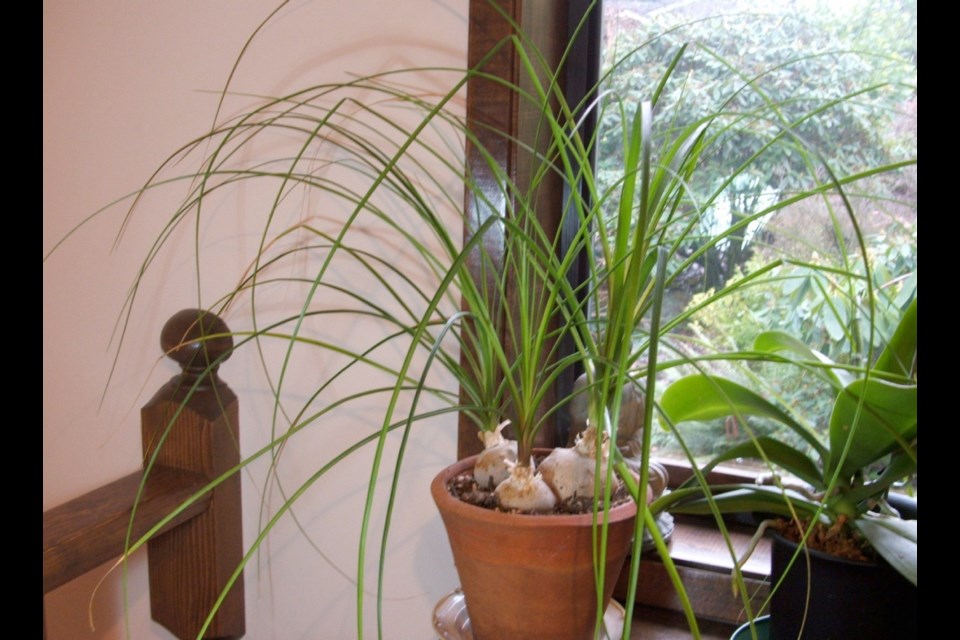Dear Helen: I’m looking for an easily cared for house plant, and am wondering what you think about “ponytail palm.”
L.G.
Dear L.G.: Ponytail (elephant foot, bottle palm, Beaucarnea recurvata) is a fabulously low-care house plant with a bulbous base or bases and long, slim leaves that curve downward to form a graceful fountain shape. The swollen bases store water.
Ponytail is native to arid desert areas of Mexico. The plants tolerate dry air and thrive in average warmth and bright light. I’ve had a plant in a clay pot at a kitchen window for years. I water it occasionally (but thoroughly) and groom the plant now and then by pulling away faded leaves. Repotting is recommended every three years or so, in spring.
Dear Helen: I have areas in my rock garden where I’d like to establish patches of sedums that form thick, ground-hugging mats. What are the best ones?
C.N.
Dear C.N.: There are many varieties of these low-growing sedums. Some are evergreen and others die back in winter. In rock gardens it is best to avoid the most vigorously spreading ones like Sedum acre ‘Aureum’ (golden mossy stonecrop).
One of my favourites is spoon-leaved stonecrop (S. spathulifolium). Commonly available forms are Cape Blanco with silvery white leaves, and Purpureum with powdery purple-blue leaves. Both have yellow flowers in summer. My Cape Blanco patches turn bright red in summer.
S. spurium (dragon’s blood stonecrop) is popular for its thick, dense foliage and red, pink or white summer flowers depending on the variety. S. kamtschaticum ‘Variegatum’ is very nice with white-edged green leaves. It dies back in winter. This one gradually died out in my garden.
These fleshy, succulent plants are good for hot, dry places and suit being used on slopes and at bed edges. Check out perennials.com for profiles of numerous varieties.
Dear Helen: How can wood ashes be used in gardens?
H.A.
Dear H.A.: They need to be used very carefully. Ashes are highly alkaline and fast-acting. They are also a significant source of potassium. Ashes from hardwood trees yield higher potassium levels than ashes from softwood trees like our local conifers.
Use ashes sparingly, and not near acid-loving plants. Ashes can burn seedlings if too much is used to prepare the soil for sowing.
One of my old, inherited British garden books praises the virtues of wood ashes “for mixing with heavy soil when planting out sweet peas, gladioli and other plants that are put out in spring.”
Be careful where you disperse ashes. A friend was puzzled when a lovely blue-flowering hydrangea turned a muddy pink one year. Her husband had dumped wood stove ashes under it.
GARDEN EVENTS
Seedy in Victoria. The James Bay Market Society hosts Victoria’s Seedy Saturday this weekend, 10 a.m. to 4 p.m. at the Victoria Conference Centre, 720 Douglas St. New seed sellers will join more than 50 exhibitors this year. There will be plants, food and garden products, chef demonstrations, kids’ activities, master gardeners and more. Speakers will explore growing in small spaces, creating wildlife habitats in urban areas, seed-saving systems and permaculture design. Admission is $7 cash, children under 12 free. jamesbaymarket.com/seedysaturday.
Helleborganza. Fraser’s Thimble Farms, 175 Arbutus Rd. on Saltspring Island, has its annual event from Saturday through Feb. 24, 9 a.m. to 4:30 p.m. This festival of winter-blooming perennials includes 200 hellebore varieties, Japanese hepaticas, winter aconites, species snowdrops and Adonis. Details at thimblefarms.com and click on Helleborganza.
HCP courses. The Horticultural Centre of the Pacific, 505 Quayle Rd. in Saanich, is offering the following courses. To register, call 250-479-6162. hcp.ca.
n The Backyard Orchard, Feb. 23, March 2, 9 and 16, 9 a.m. to noon. Learn about how to grow tree, shrub and cane fruits and nuts in an urban space. Cost to members $140, others $196.
n Spring Checklist, Feb. 24, 1 to 4 p.m. Covered will be the best tools and how to use them, general maintenance techniques and pruning basics. The classroom session will be followed by observing examples in the gardens. Cost to members $25, others $35.
